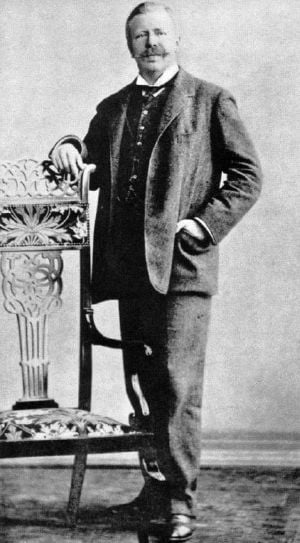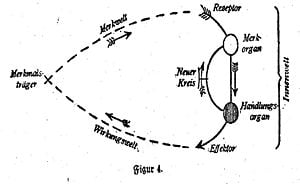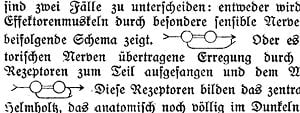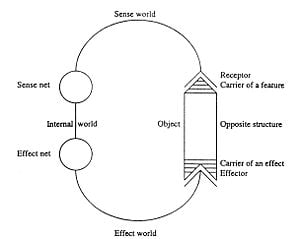Difference between revisions of "Jakob von Uexküll" - New World Encyclopedia
Keisuke Noda (talk | contribs) (→Life) |
Keisuke Noda (talk | contribs) (→Life) |
||
| Line 8: | Line 8: | ||
| − | |||
According to [[Giorgio Agamben]], Uexküll had been a [[baron]] before his family lost most of their fortune in [[World War I]], although Uexküll managed to retain a [[villa]] on [[Capri]] where the [[critic]], [[historian]] and [[philosopher]] [[Walter Benjamin]] stayed for some time. Needing to support himself, Uexküll took a job as professor at the [[University of Hamburg]] where he founded the [[Institut für Umweltforschung]]. | According to [[Giorgio Agamben]], Uexküll had been a [[baron]] before his family lost most of their fortune in [[World War I]], although Uexküll managed to retain a [[villa]] on [[Capri]] where the [[critic]], [[historian]] and [[philosopher]] [[Walter Benjamin]] stayed for some time. Needing to support himself, Uexküll took a job as professor at the [[University of Hamburg]] where he founded the [[Institut für Umweltforschung]]. | ||
He died on the island of Capri in July 25, 1944. | He died on the island of Capri in July 25, 1944. | ||
Revision as of 03:02, 6 January 2009
Jakob Johann von Uexküll (September 8, 1864 - July 25, 1944) was a Baltic German biologist who had important achievements in the fields of muscular physiology, animal behaviour studies, and the cybernetics of life. However, his most notable achievement is the notion of umwelt, used by semiotician Thomas Sebeok. His works established biosemiotics.
Life
Jakob von Uexküll was born in Keblaste (today, Mihkli), Estonia, on September 8, 1864. He studied zoology, from 1884 to 1889, at the University of Dorpat (today, Tartu), and, from 1837 to 1900, physiology of animal locomotorium at the University of Heidelberg. In 1907, he received a honorary doctorate from the University of Heidelberg for his studies on the muscular physiology.
Uexkull began to develop a new perspective on biology contrary to dominant mechanistic views. He took a position similar to vitalism of Hans Driesch (1867 - 1941), and argued that each species of animal perceives its living environment from its unique subjective perspective. Uexkull introduced a concept of subjectivity (of each species) to biology and described the environment as that which is perceived by subjective element of each species. Uexkull took Kantian philosophical perspective in his theory of biology.
According to Giorgio Agamben, Uexküll had been a baron before his family lost most of their fortune in World War I, although Uexküll managed to retain a villa on Capri where the critic, historian and philosopher Walter Benjamin stayed for some time. Needing to support himself, Uexküll took a job as professor at the University of Hamburg where he founded the Institut für Umweltforschung.
He died on the island of Capri in July 25, 1944.
His son is Thure von Uexküll. His grandson is Jakob von Uexkull.
Perspective from each species
There, Uexküll became interested in how living beings subjectively perceive their environment(s). Picture, for example, a meadow as seen through the compound eyes of a fly, continually flying through the air, and then as seen in black and white by a dog (with its highly efficient sense of smell), and then again from the point of view of a human or a blind tick. Furthermore, think of what time means to each of these different beings with their relative lifespans. Uexküll called these subjective spatio-temporal worlds Umwelt. These umwelten are distinctive from what Uexküll termed the "Umgebung" which would be objective reality were such a reality to exist. Each being perceives its own umwelt to be the objective Umgebung, but this is merely perceptual bias.
Uexküll's writings show a specific interest in the various worlds that exist ('conceptually') from the point of view of the Umwelt of different creatures such as ticks, sea urchins, amoebae, jellyfish and sea worms. This gives some of his writings a poetic quality.
Biosemiotics
The biosemiotic turn in Jakob von Uexküll's analysis occurs in his discussion of the animal's relationship with its environment. The umwelt is for him an environment-world which is (according to Agamben), "constituted by a more or less broad series of elements [called] "carriers of significance" or "marks" which are the only things that interest the animal." Agamben goes on to paraphrase one example from Uexküll's discussion of a tick, saying,
"...this eyeless animal finds the way to her watchpoint [at the top of a tall blade of grass] with the help of only its skin’s general sensitivity to light. The approach of her prey becomes apparent to this blind and deaf bandit only through her sense of smell. The odor of butyric acid, which emanates from the sebaceous follicles of all mammals, works on the tick as a signal that causes her to abandon her post (on top of the blade of grass/bush) and fall blindly downward toward her prey. If she is fortunate enough to fall on something warm (which she perceives by means of an organ sensible to a precise temperature) then she has attained her prey, the warm-blooded animal, and thereafter needs only the help of her sense of touch to find the least hairy spot possible and embed herself up to her head in the cutaneous tissue of her prey. She can now slowly suck up a stream of warm blood."
Thus, for the tick, the umwelt is reduced to only three (biosemiotic) carriers of significance: (1) The odor of butyric acid, which emanates from the sebaceous follicles of all mammals, (2) The temperature of 37 degrees celsius (corresponding to the blood of all mammals), (3) The hairy typology of mammals.
Umwelt
According to Jakob von Uexküll and Thomas A. Sebeok, umwelt (plural: umwelten; the German word Umwelt means "environment" or "surrounding world") is the "biological foundations that lie at the very epicenter of the study of both communication and signification in the human [and non-human] animal." The term is usually translated as "self-centered world." Uexküll theorised that organisms can have different umwelten, even though they share the same environment.
Discussion
Each functional component of an umwelt has a meaning and so represents the organism's model of the world. It is also the semiotic world of the organism, including all the meaningful aspects of the world for any particular organism, i.e. it can be water, food, shelter, potential threats, or points of reference for navigation. An organism creates and reshapes its own umwelt when it interacts with the world. This is termed a 'functional circle'. The umwelt theory states that the mind and the world are inseparable, because it is the mind that interprets the world for the organism. Consequently, the umwelten of different organisms differ, which follows from the individuality and uniqueness of the history of every single organism. When two umwelten interact, this creates a semiosphere.
As a term, umwelt also unites all the semiotic processes of an organism into a whole. Internally, an organism is the sum of its parts operating in functional circles and, to survive, all the parts must work together co-operatively. This is termed the 'collective umwelt' which models the organism as a centralised system from the cellular level upward. This requires the semiosis of any one part to be continuously connected to any other semiosis operating within the same organism. If anything disrupts this process, the organism will not operate efficiently. But, when semiosis operates, the organism exhibits goal-oriented or intentional behaviour.
Philosophical influences
Works by scholars such as Kalevi Kull connect Uexküll's studies with some areas of philosophy such as phenomenology and hermeneutics. Jakob von Uexküll is also considered a pioneer of semiotic biology, or biosemiotics. However despite his influence (on the work of philosophers Martin Heidegger, Maurice Merleau-Ponty, Gilles Deleuze and Félix Guattari (in their A Thousand Plateaus), for example) he is still not widely known, and his books are mostly out of print in German and in English, although a paperback French translation of Streifzüge durch die Umwelten von Tieren und Menschen [A stroll through the Umwelten of animals and humans] is currently in print.
ReferencesISBN links support NWE through referral fees
- Agamben, Giorgio. "Chapter 10, “Umwelt”" in The Open: Man and Animal, translated by Kevin Attell (Originally published in Italian in 2002 under the title L'aperto: l'uomo e l'animale), Stanford, CA., Stanford University Press, 2004. ISBN 978-0804747370
- Brauckmann, Sabine. 2001. "From the Haptic-Optic Space to Our Environment: Jakob Von Uexkull and Richard Woltereck". Semiotica. 134, no. 1: 293.
- Buchanan, Brett. Onto-Ethologies: The Animal Environments of Uexküll, Heidegger, Merleau-Ponty, and Deleuze. Albany: SUNY Press, 2008. ISBN 9780791476116
- Figge, Udo L. 2001. "Jakob Von Uexkull: Merkmale and Wirkmale". Semiotica. 134, no. 1: 193.
- Heusden, Barend van.2001. "Jakob Von Uexkull and Ernst Cassirer". Semiotica. 134, no. 1: 275.
- Kull, Kalevi. 1998. “On Semiosis, Umwelt, and Semiosphere.” Semiotica, Vol. 120(3/4), pp. 299-310.
- Kull, Kalevi. "Special Issue Jakob Von Uexküll: A Paradigm for Biology and Semiotics." Semiotica, vol. 134,1/4. Berlin: Mouton de Gruyter, 2001.
- Lagerspetz, K. Y. H. 2001. "Jakob Von Uexkull and the Origins of Cybernetics". Semiotica. 134: 643-652.
- Patten, Bernard C. 2001. "Jakob Von Uexkull and the Theory of Environs". Semiotica. 134, no. 1: 423.
- Sax, Boria, and Peter H Klopfer. 2001. "Jakob Von Uexkull and the Anticipation of Sociobiology". Semiotica. 134, no. 1: 767.
- Schiller, Claire H., and D. J. Kuenen. Instinctive Behavior; The Development of a Modern Concept. New York: International Universities Press, 1957.
- Uexküll, Jakob von, and Herber Girardet. Shanping Our Future: Creating the World Future Council. RSD buchan, Vic: Wwoof Pty Ltd, 2006. ISBN 9780646455891
- Uexküll, Jakob von. "A Stroll Through the Worlds of Animals and Men: A Picture Book of Invisible Worlds," Instinctive Behavior: The Develepment of a Modern Concept, ed. and trans. Claire H. Schiller, New York: International Universities Press, Inc., 1957.
- Uexkull, Jakob von. 2001. "The New Concept of Umwelt: A Link between Science and the Humanities". Semiotica. 134, no. 1: 111.
- Ziemke, T., and N. E. Sharkey. 2001. "A Stroll Through the Worlds of Robots and Animals: Applying Jakob Von Uexkull's Theory of Meaning to Adaptive Robots and Artificial Life". Semiotica. 134: 701-746.
External links
All links are retrieved January 5, 2009.
- Jakob von Uexküll, Theoretical Biology, Biocybernetics and Biosemiotics (Journal article)
- Jakob von Uexküll and his "Institut für Umweltforschung in Hamburg" (PPT - Presentation)
- Umwelt by John Deely
- Pragmatism and Umwelt-theory by Alexei Sharov
- Jakob von Uexküll, Institute for theoretical biology, biocybernetics and biosemiotics at the university of Hamburg. (German)
Credits
New World Encyclopedia writers and editors rewrote and completed the Wikipedia article in accordance with New World Encyclopedia standards. This article abides by terms of the Creative Commons CC-by-sa 3.0 License (CC-by-sa), which may be used and disseminated with proper attribution. Credit is due under the terms of this license that can reference both the New World Encyclopedia contributors and the selfless volunteer contributors of the Wikimedia Foundation. To cite this article click here for a list of acceptable citing formats.The history of earlier contributions by wikipedians is accessible to researchers here:
The history of this article since it was imported to New World Encyclopedia:
Note: Some restrictions may apply to use of individual images which are separately licensed.



